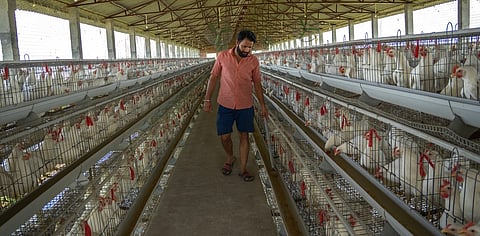

The strain of H5N1 avian flu virus that infected a teenager in the Canadian province of British Columbia is different from that responsible for infection in dairy cows and other animal outbreaks reported in the United States.
The teenager was hospitalised on November 9. Lab tests later confirmed the diagnosis to be avian influenza H5N1.
The genomic sequencing result showed the virus to be unrelated to the strain causing the ongoing outbreak in poultry reported in the province (Influenza A (H5N1), clade 2.3.4.4b, genotype D1.1).
“The genotype of H5N1 avian influenza in dairy cattle in the US is not the same as the genotype confirmed in the domestically acquired human case in British Columbia,” said a statement from the Public Health Agency of Canada (PHAC).
The teenager is in a critical condition and is undergoing treatment.
No new infections in humans have been reported in Canada since and the authorities continue to maintain the human risk due to virus as low. The source of the infection in the teen has not been determined yet.
Scientists said the incident shows that the virus could have undergone mutations, making it easier to infect people.
Scott Hensley, a professor at Penn Institute of Immunology explained the case in a series of threads on social media platform Bluesky.
Hensley said the preliminary sequence of the virus traced from the teenager was ‘no good news’. He pointed to a recent study which found that single mutations changed receptor binding preference from a bird receptor to a human receptor.
He further stated that the genetic sequence of the virus showed mutations in the hemagglutinin, a protein on the viral surface that binds to cells the virus is attempting to invade. The data was showed by the PHAC on its open database.
The study found that H5N1’s hemagglutinin, which primarily binds to cells of bird receptors alpha 2-3 found widely in wild birds and poultry, is also found in the tissue around the human eyes, conjunctiva and upper respiratory tract.
These receptors in humans are known as alpha 2-6.
The teenager had reported of conjunctivitis, fever and cough on November 2.
Hensley commented, “Recent clade 2.3.4.4b human cases have been somewhat mild. However, the teenager from British Columbia appears to be very sick and in the intensive care unit. We need to closely monitor this situation and increase our surveillance efforts.”
Responding to Hensley, Jesse Bloom, an evolutionary virologist at the Fred Hutchinson Cancer Center in Seattle said the two mutations found in the British Columbia teenager virus are known to enable flu viruses make this attachment switch. “Both these sites play an important role in … binding specificity,” he stated.
Commenting on the lab report, J Weiland, an infectious disease modeller posted on X (formerly twitter), “This is actually concerning. The sequence of the hospitalised teen with H5N1 has been released. Both of these mutation sites are known to impact α2,6 binding that is needed for human-to-human transmissibility.”
According to US-based Centers for Disease Control and Prevention (CDC), 53 humans have been infected with the virus since 2024 in the country. Thirty-one were infected due to exposure from cattle and 21 by poultry.
The latest case, reported from an Oregon poultry farm, is the first human case of H5N1 bird flu.
“These farm workers all described mild symptoms, many with eye redness or discharge (conjunctivitis). Some workers who tested positive in Washington reported some mild upper respiratory symptoms,” the CDC said in a statement issued on November 18.
The CDC recently expressed concerns over the virus’s adaptability after the H5 virus was found to have infected pigs as reported on October 31.
On November 4, it issued a statement over the A (H5) virus’s adaptability in pigs, known to be susceptible to influenza viruses affecting humans, birds and other animals.